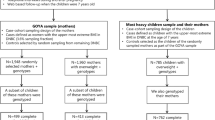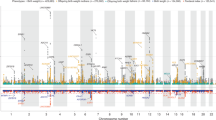Abstract
To identify some of the genetic factors that contribute to obesity in children of Central European and North African descent, we studied the parental transmission of alleles at the insulin locus to offspring with early-onset obesity. A variable nucleotide tandem repeat (VNTR) polymorphism upstream of the insulin gene (INS) is associated with variations in the expression of INS and the nearby gene encoding insulin-like growth factor 2 (IGF2). We found an excess of paternal transmission of class I VNTR alleles to obese children: children who inherited a class I allele from their father (but not those inheriting it from their mother) had a relative risk of early-onset obesity of 1.8. Due to the frequency of class I alleles in this population, this risk concerns 65–70% of all infants. These results suggest that increased in utero expression of paternal INS or IGF2 due to the class I INS VNTR allele may predispose offspring to postnatal fat deposition.
This is a preview of subscription content, access via your institution
Access options
Subscribe to this journal
Receive 12 print issues and online access
$209.00 per year
only $17.42 per issue
Buy this article
- Purchase on Springer Link
- Instant access to full article PDF
Prices may be subject to local taxes which are calculated during checkout
Similar content being viewed by others
References
Bundred, P., Kitchiner, D. & Buchan, I. Prevalence of overweight and obese children between 1989 and 1998: population based series of cross sectional studies. Br. Med. J. 322, 313–314 (2001).
Taniguchi, A., Kono, T., Okuda, H., Oseko, F., Nagata, I., Kataoka, K. & Imura, H. Neutral glyceride synthesis from glucose in human adipose tissue: comparison between growing and mature subjects. J. Lipid. Res. 27, 925–929 (1986).
Le Stunff, C., Fallin, D., Schork, N.J. & Bougnères, P. The insulin gene VNTR is associated with fasting insulin levels and development of juvenile obesity. Nature Genet. 26, 444–446 (2000).
Kennedy, G.C., German, M.S. & Rutter, W.J. The minisatellite in the diabetes susceptibility locus IDDM2 regulates insulin transcription. Nature Genet. 9, 293–298 (1995).
Paquette, J., Giannoukakis, N., Polychronakos, C., Vafiadis, P. & Deal, C. The INS 5′ variable number of tandem repeats is associated with IGF2 expression in humans. J. Biol. Chem. 273, 14158–14164 (1998).
Reik, W. & Walter, J. Genomic imprinting: parental influence on the genome. Nature Rev. Genet. 2, 21–32 (2001).
Vafiadis, P. et al. Imprinted and genotype-specific expression of genes at the IDDM2 locus in pancreas and leucocytes. J. Autoimmun. 9, 397–403 (1996).
Bennett, S.T. et al. IDDM2-VNTR-encoded susceptibility to type 1 diabetes: dominant protection and parental transmission of alleles of the insulin gene-linked minisatellite locus. J. Autoimmun. 9, 415–421 (1996).
Eaves, I.A. et al. Transmission ratio distortion at the INS-IGF2 VNTR. Nature Genet. 22, 324–325 (1999).
Bennett, S.T. & Todd, J.A. Human type 1 diabetes and the insulin gene: principles of mapping polygenes. Annu. Rev. Genet. 30, 343–370 (1996).
Huxtable, S.J. et al. Analysis of parent-offspring trios provides evidence for linkage and association between the insulin gene and type 2 diabetes mediated exclusively through paternally transmitted class III variable number tandem repeat alleles. Diabetes 49, 126–130 (2000).
Weinberg, C.R. Methods for detection of parent-of-origin effects in genetic studies of case-parents triads. Am. J. Hum. Genet. 65, 229–235 (1999).
Weinberg, C.R., Wilcox, A.J. & Lie, R.T. A log-linear approach to case-parent-triad data: assessing effects of disease genes that act either directly or through maternal effects and that may be subject to parental imprinting. Am. J. Hum. Genet. 62, 969–978 (1998).
Schaid, D.J. Likelihoods and TDT for the case-parents design. Genet. Epidemiol. 16, 250–260 (1999).
Sham, P.C. & Curtis, D. An extended transmission/disequilibrium test (TDT) for multi-allele marker loci. Ann. Hum. Genet. 59, 323–336 (1995).
Giannoukakis, N., Deal, C., Paquette, J., Goodyer, C.G. & Polychronakos, C. Parental genomic imprinting of the human IGF2 gene. Nature Genet. 4, 98–101 (1993).
Moore, G.E. et al. Evidence that insulin is imprinted in the human yolk sac. Diabetes 50, 199–203 (2001).
Lew, A., Rutter, W.J. & Kennedy, G.C. Unusual DNA structure of the diabetes susceptibility locus IDDM2 and its effect on transcription by the insulin promoter factor Pur-1/MAZ. Proc. Natl. Acad. Sci. USA 97, 12508–12512 (2000).
Whitaker, R.C. & Dietz, W.H. Role of the prenatal environment in the development of obesity. J. Pediatr. 132, 768–776 (1998).
Dunger, D.B. et al. Association of the INS VNTR with size at birth. ALSPAC Study Team. Avon Longitudinal Study of Pregnancy and Childhood. Nature Genet. 19, 268–270 (1998).
Hattersley, A.T., Beards, F., Ballantyne, E., Appleton, M., Harvey, R. & Ellard, S. Mutations in the glucokinase gene of the fetus result in reduced birth weight. Nature Genet. 19, 268–270 (1998).
Catalano, P.M., Thomas, A.J., Huston, L.P. & Fung, C.M. Effect of maternal metabolism on fetal growth and body composition. Diabetes Care 21, B85–B90 (1998)
Battaglia, F.C. & Thureen P.J. Nutrition of the fetus and the premature infant. Diabetes Care 21, B70–B74 (1998)
Dietz, W.H. Critical periods in childhood for the development of obesity. Am. J. Clin. Nutr. 59, 955–959 (1994).
Cavalli-Sforza, L.L., Menozzi, P. & Piazza, A. History and Geography of Human Genes, 169–172 and 255–301 (Princeton University Press, Princeton, 1994).
International Obesity Task Force. Obesity: Preventing and managing the global epidemic. Report of a WHO consultation on Obesity, 3–5 June 1998, Geneva: WHO (1998).
Freeman, J.V., Power, C., Rodgers, B. Weight-for-height indices of adiposity: relationships with height in childhood and early adult life. Int. J. Epidemiol. 24, 970–976 (1995).
Cole, T.J., Freeman, J.V., Preece, M.A. Body mass index reference curves for the UK. Arch. Dis. Child 73, 25–29 (1995).
Acknowledgements
We thank A. Dermane and C. Dos Santos for their skillful study of clinical and genotype data.
Author information
Authors and Affiliations
Corresponding author
Rights and permissions
About this article
Cite this article
Le Stunff, C., Fallin, D. & Bougnères, P. Paternal transmission of the very common class I INS VNTR alleles predisposes to childhood obesity. Nat Genet 29, 96–99 (2001). https://doi.org/10.1038/ng707
Received:
Accepted:
Published:
Issue Date:
DOI: https://doi.org/10.1038/ng707
This article is cited by
-
The association of insertions/deletions (INDELs) and variable number tandem repeats (VNTRs) with obesity and its related traits and complications
Journal of Physiological Anthropology (2017)
-
Association of genetic variants in INS (rs689), INSR (rs1799816) and PP1G.G (rs1799999) with type 2 diabetes (T2D): a case–control study in three ethnic groups from North-West India
Molecular Genetics and Genomics (2016)
-
Epigenetic effects of paternal diet on offspring: emphasis on obesity
Endocrine (2015)
-
Maternal Nutrition and Epigenetics in Early Life
Current Nutrition Reports (2013)
-
Epigenetic regulation in obesity
International Journal of Obesity (2012)



